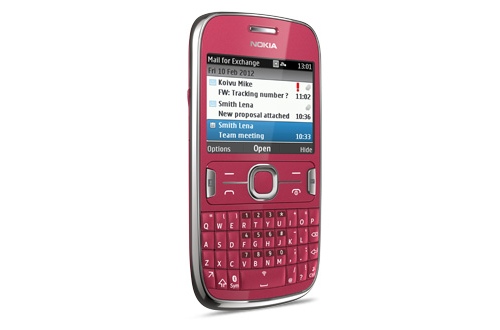The great Asha mystery: Why is Nokia playing dumb on smartphones?

Nokia put out its fourth quarter and 2012 financials on Thursday, with smartphone sales notably down year-on-year.

According to Nokia's own reckoning, "smart device" shipments were down by 66 percent in the fourth quarter of 2012 compared to the year before. In Q4 2011, Nokia sold 19.6 million units; by Q4 2012, that had fallen to 6.6 million.
In Nokia's world, there are two types of mobile handsets: "smart devices" and "mobile phones," with the three platforms Nokia phones run--Windows Phone, Symbian, and Series 40--divided between them. Symbian and Windows Phone handsets make up the "smart device" category, the latter now accounting for two-thirds of sales.
"Mobile phones" are the lower-end, feature phone type devices, and exclusively run Series 40, a platform Nokia began using back in the last millennium. They still make up the lion's share of Nokia's phone shipments today--80 million sold in the last quarter (a slight dip compared to the 94 million it sold the same quarter of 2011, but a far better performance than its smart device counterparts).
But around the middle of 2012, something began happening to Nokia's Series 40 devices. In the second quarter of 2012, Series 40 devices were very much described by the company (PDF) as "mobile phones" or "feature phones". "In June, Nokia launched its first full touch Asha [Series 40] feature phones. The three new models--the Nokia Asha 305, Nokia Asha 306, and Nokia Asha 311--offer a fully redesigned touch user interface," the results said.
Three months on, Asha devices had magically become smartphones. "The Asha 308 and Asha 309 offer a fluid 'swipe' user interface and an open environment for third-party application development, characteristics that have earned the complete Asha Touch range full smartphone classification from global market research companies and analysts, such as GfK," the third quarter results (PDF) said.
It's an interesting classification. Presumably non-touch Asha and other Series 40 devices are not smartphones then, despite having the same OS and largely the same capabilities. But isn't it the features of a device's OS that determine whether it's classed as a smartphone, or otherwise?
Nokia would disagree. In a post on its Conversations blog, published today, Nokia's VP of product marketing, Jussi Nevanlinna, is asked 'so what is a smartphone and how do some Nokia Asha phones fall into that category?" He replied, "There seems to be three things that people expect. The first is a touchscreen. Then, inside, they expect web browsing, and the integration of certain apps and services into the operating system, especially in the areas of social and location. And third, that they have the ability to get more apps."
It's a definition of smartphones many would not recognise, on all three points. Do smartphones need a touchscreen? No. Symbian and BlackBerry devices have been classified as smartphones for years without one. Web browsing and the integration of certain apps into the operating system? Absolutely. But Series 40's apps are web-based rather than running on the OS, which one would typically expect from a smartphone. And the ability to get more apps? OK, you can't argue with that. But non-touch Asha devices can still get access to the same apps as their touchscreen counterparts, and run them in the same way, yet are not deemed smartphones.
Almost every mobile watcher I know would struggle to describe Asha touch devices as smartphones. They are low-end devices, built to cope with low data rate networks and without native apps. Yet Nokia prefers the "smartphone" label.
It seems Nokia rather wants to have its cake and eat it on the smartphone issue. In its fourth-quarter results (PDF), Series 40 devices in general and Asha touch phones in particular were still very much part of its "mobile phones" category, yet the latter were also referred to as smartphones elsewhere in the results:
Smartphone volumes
In the fourth quarter 2012, Devices & Services total smartphone volumes were 15.9 million units, composed of:
9.3 million Asha full touch smartphones in Mobile Phones
4.4 million Lumia smartphones in Smart Devices
2.2 million Symbian smartphones in Smart Devices
Why Nokia would embrace this confusion, we can only guess.
Presumably, selling 6.6 million smartphones in the high-volume Christmas quarter--a third of which are on a platform that has now been abandoned--doesn't look good in investors' eyes, particularly when Nokia was able to shift more in the region of 30 million genuinely smart devices per quarter not so long ago.
It may be preparing those investors for the time--not too far away now--when Nokia stops Symbian device shipments altogether, taking millions more units out of that "smart devices" category. Nokia may then wish to slip Asha into the "smart device" category as a replacement to make up the difference, regardless of whether Asha devices really are smartphones or not.
It may even be a sign that Nokia is still leery of a two-platform strategy--Windows Phone for the high-end, Series 40 for the low-end--and is seeking to use its "Asha smartphones" as a bridge and erstwhile third platform. That way, it could split out the millions of sales it gets for its Series 40 devices across "smart devices" and "mobile phones," bolstering the high-end category if Windows Phone is not able to deliver the goods on its own.
Whatever the reasoning, when it comes to smart devices, it seems Nokia may be wilfully choosing to play dumb.